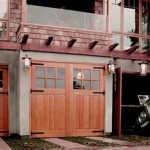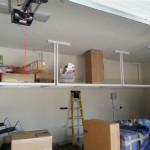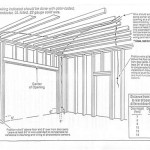```html
Best Way to Organize Garage Shelves
The garage, often relegated to a repository for discarded items and miscellaneous tools, can quickly become a chaotic space. A well-organized garage, however, offers not only improved storage capacity but also contributes to a safer and more functional home environment. Garage shelving plays a crucial role in achieving this organization. Choosing the right shelves and implementing an effective organizational strategy are essential for maximizing space and maintaining order.
Before embarking on any organizational project, it is crucial to take stock of the existing items and assess the available space. This initial evaluation allows for informed decisions regarding the type and quantity of shelving needed, as well as the overall layout of the garage. Neglecting this crucial first step can lead to inefficient storage solutions and ultimately, a continued state of disarray.
Inventory and Decluttering: The Foundation of Garage Organization
The first step involves a comprehensive inventory of all items currently stored in the garage. Remove everything from the shelves and floor, creating a clear and unobstructed view of the space. This process allows for a realistic assessment of the volume of items requiring storage and the available space to accommodate them.
Simultaneously, implement a rigorous decluttering process. Sort items into three distinct categories: items to keep, items to donate or sell, and items to discard. Be honest and objective during this process, resisting the urge to retain items that are no longer useful or necessary. Items that have not been used in over a year, unless they hold significant sentimental value or are seasonal items, are prime candidates for removal. Consider local charities or online marketplaces for donating or selling unwanted items. Responsible disposal of unusable items is also crucial.
Once the decluttering process is complete, the remaining items should be categorized based on their intended use and frequency of access. This categorization will inform the placement of items on the shelves, ensuring that frequently used items are easily accessible while less frequently used items are stored in harder-to-reach locations.
Selecting the Right Shelving System: Materials, Types, and Capacity
The selection of appropriate shelving is paramount to effective garage organization. Various factors should be considered, including the weight and size of the items to be stored, the available space, and the overall aesthetic of the garage. Shelving options range from basic metal shelves to heavy-duty plastic shelving units and custom-built wooden shelves.
Metal shelving is a popular choice due to its durability and affordability. It is particularly well-suited for storing heavy items such as tools, automotive parts, and sporting equipment. However, metal shelves may be susceptible to rust in humid environments, so it is important to choose powder-coated or galvanized metal to prevent corrosion. Plastic shelving is another cost-effective option, offering water resistance and ease of cleaning. However, plastic shelves may not be as strong as metal shelves and are therefore better suited for storing lighter items. Wooden shelves can be custom-built to fit specific dimensions and can be stained or painted to match the garage's decor. Wooden shelves offer a more aesthetically pleasing option but may require more maintenance than metal or plastic shelves.
Consider the weight capacity of each shelving unit before making a purchase. Overloading shelves can lead to structural failure and potential injury. Distribute the weight evenly across the shelves to prevent concentrated stress points. Adjustable shelves offer flexibility in terms of vertical spacing, allowing for customization to accommodate items of varying heights. When determining the size and quantity of shelving units, account for future storage needs. It is generally advisable to overestimate rather than underestimate the amount of shelving required.
Beyond traditional standing shelves, consider utilizing overhead storage options. These racks are typically attached to the ceiling and are ideal for storing seasonal items like holiday decorations, camping gear, and luggage. Utilizing vertical space effectively maximizes the available storage capacity of the garage.
Implementing an Effective Organization Strategy: Placement, Accessibility, and Labeling
Once the shelving is in place, implementing a strategic organization plan is essential. The placement of shelves should be carefully considered to optimize both functionality and accessibility. Frequently used items should be stored on shelves that are within easy reach, while less frequently used items can be placed on higher or lower shelves.
Heavy items should be stored on the lower shelves to maintain stability and prevent injury when lifting. Avoid storing heavy items on high shelves, as this increases the risk of them falling and causing damage or injury. Consider grouping similar items together, such as gardening tools, automotive supplies, or sporting equipment. This grouping simplifies the process of locating items when needed.
Clear and consistent labeling is crucial for maintaining an organized garage. Label each shelf or container with a descriptive name, indicating the contents within. This labeling system enables quick identification of items and prevents unnecessary searching. Use a label maker or permanent marker to create durable and legible labels. Consider using color-coded labels to further categorize items and streamline the organization process.
Containers and bins can be used to further organize items on the shelves. Clear plastic bins allow for easy visibility of the contents, while opaque bins can be used to conceal clutter. Choose containers that are appropriately sized for the items being stored and that are stackable to maximize space utilization. Avoid overfilling containers, as this can make them difficult to lift and carry.
Regular maintenance is essential for preserving the organization of the garage shelves. Periodically review the contents of the shelves, removing any items that are no longer needed or used. This periodic decluttering prevents the accumulation of unnecessary items and maintains a streamlined organization system. Dust and clean the shelves regularly to prevent the buildup of dirt and grime.
Consider installing adequate lighting in the garage to improve visibility and make it easier to locate items. Proper lighting enhances safety and functionality, particularly in dimly lit corners or areas with limited natural light. Task lighting can be installed above workbenches or specific shelving units to provide focused illumination.
Following these steps will help transform a chaotic garage into an organized and functional space, maximizing storage capacity and improving the overall efficiency of your home.
```
46 Garage Organizing Ideas You Can Diy Family Handyman

23 Tips Tricks Ideas For Organizing Your Garage Extra Space Storage

12 Garage Storage Ideas How To Organize A

23 Tips Tricks Ideas For Organizing Your Garage Extra Space Storage

15 Tips On How To Organize Your Garage And Reclaim Space

How To Organize The Garage Organization Ideas Making Lemonade

How To Build Garage Shelves The Easy Way Infarrantly Creative

Diy Garage Ceiling Storage And Wall Organization Angela Marie Made

A Step By Guide To Planning Garage Organization Project Abby Organizes

Garage Organization Five Simple Steps To Bring Order The Pegboard Remodelando La Casa
Related Posts








